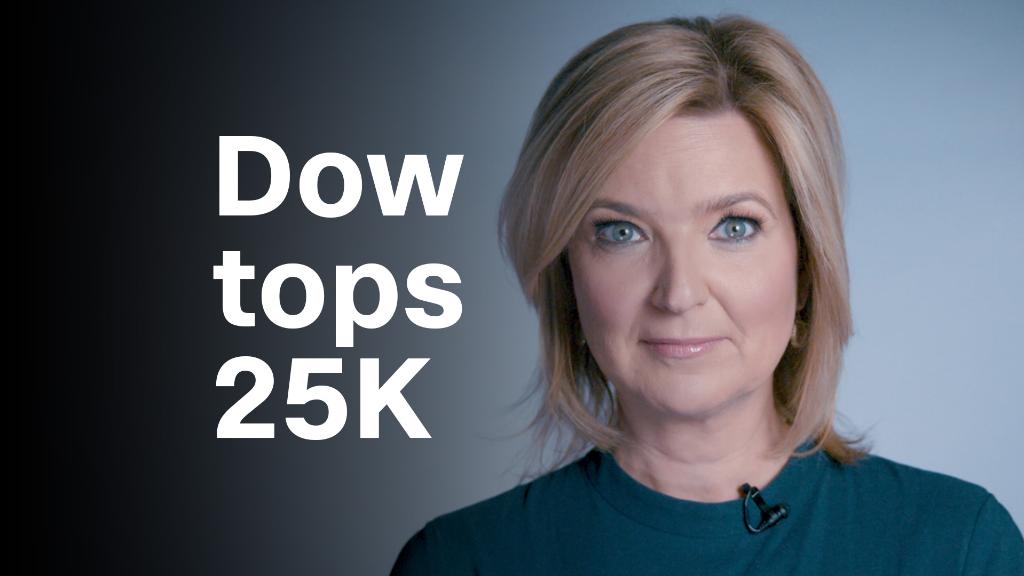
The stock market is off to a sizzling-hot start to 2018.
After enjoying a blockbuster first year under President Trump, the Dow soared another 2.3% last week and broke through 25,000. That's the strongest kickoff to a year through four trading days since 2003, a year that saw the Dow surge 25%.
The Nasdaq, fueled by powerful rallies from tech stocks like Nvidia (NVDA) and Micron (MU), raced 3.4% higher last week. That's the Nasdaq's best start to a new year since 2006.
Clearly, Trump's tax overhaul is making Wall Street very excited about all the money corporations will save. Investors are also encouraged by signs that the U.S. and global economy continue to strengthen. The markets are betting more good news will come from earnings season, which begins in earnest this week.
"The global economy is providing a clearly bullish signal for earnings and stock prices," Ed Yardeni, president of investment advisory Yardeni Research, wrote in a note on Monday.
Stocks dipped a bit on Monday, with the Dow losing around 30 points.
Still, it's an impressive start considering how hard Wall Street has partied since the 2016 election. The Dow and Nasdaq have spiked about 38% since Trump's victory. Last year was the Dow's best since 2013.
It's also a huge reversal from two years ago, when worries about China's economic slowdown and crashing oil prices caused Wall Street's worst start to a year on record.
Related: Tax law to spark $450 billion buyout bonanza
Unlike the beginning of 2016, markets are unusually quiet right now. The VIX (VIX), a measure of market volatility, closed at its second-lowest level ever on January 3.
It's normal -- and even healthy -- for the stock market to take a breather by retreating. Yet the S&P 500 hasn't suffered a 3% dip since just before the November 2016 election. That's the longest such streak on record.
Few economists believe the tax overhaul will spark a lasting economic boom. Yet shareholders are poised to be rewarded anyway, especially when corporations return the mountain of money sitting overseas.
S&P 500 companies are likely to use that repatriated foreign cash to buy back around $450 billion of stock, Bank of America predicted. That buyback bonanza should help lift earnings per share and further support stock prices.
However, some believe there are caution flags flapping on Wall Street.
"Our market internal measures, including breadth, leadership, sentiment and volume, have reached extremes that warrant some attention," Katie Stockton, chief technical strategist at brokerage BTIG, wrote in a report on Sunday. She added that sentiment has become "too complacent."
If stocks do finally suffer a setback, Stockton urged investors not to freak out. "We would view it as a buying opportunity," she said.
Related: Why Wall Street's tax party could be short-lived
So, what would it take to disrupt the steady march higher on Wall Street?
One area to keep a close eye on is the bond market. The stock market looks expensive. However, investors often shrug that off because bonds rates remain extremely low, making stocks look good by comparison. Any change to that recipe could derail the stock market.
Barry Bannister, chief equity strategist at Stifel, warned in a report on Monday that a "fairly rapid rise" in bond rates will cause the S&P 500 to suffer a 5% pullback during the first six months of 2018.
What would the trigger be? The tax law that excited Wall Street. Bannister expects the bond market to begin raising rates ahead of the Federal Reserve, lifting the 10-year Treasury rate from 2.5% now to 2.96%.
"Fiscal stimulus actually facilities the very Fed rate hikes that begin to choke the S&P 500 in 2018," Bannister predicted.


